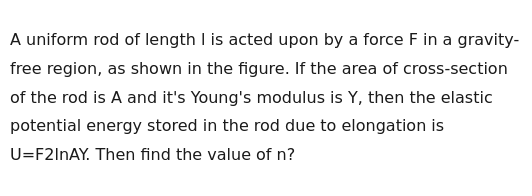Question
Question: A uniform rod of length l is acted upon by a force F in a gravity-free region, as shown in the figur...
A uniform rod of length l is acted upon by a force F in a gravity-free region, as shown in the figure. If the area of cross-section of the rod is A and it's Young's modulus is Y, then the elastic potential energy stored in the rod due to elongation is U=F2lnAY. Then find the value of n?

6
Solution
The problem describes a uniform rod of length l acted upon by a force F in a gravity-free region. The figure shows a single force F applied at one end of the rod. In a gravity-free region, if a single force F is applied to a free body of mass m, the body accelerates with a=F/m. In this case, the tension within the rod is not uniform; it varies along the length.
Let's assume the force F is applied at one end, say the end at x=l, and the other end is at x=0. Let the rod have mass m. The acceleration of the rod is a=F/m. Consider a cross-section at a distance x from the free end (at x=0, where no force is applied). The part of the rod from 0 to x has mass m(x/l). This part is accelerated by the tension T(x) at the cross-section at x.
Using Newton's second law for the segment from 0 to x: T(x)=(mass of segment)×(acceleration) T(x)=(lmx)a=(lmx)(mF)=lFx. The tension varies linearly from 0 at the free end (x=0) to F at the end where the force is applied (x=l).
The strain at a distance x from the free end is given by Hooke's law: ϵ(x)=YStress(x)=YT(x)/A=AYFx/l=lAYFx.
The elastic potential energy stored in a small element of length dx at position x is given by: dU=21×Stress(x)×Strain(x)×Volume of element dU=21×AT(x)×ϵ(x)×(Adx) dU=21T(x)ϵ(x)dx Substitute the expressions for T(x) and ϵ(x): dU=21(lFx)(lAYFx)dx=21l2AYF2x2dx.
To find the total elastic potential energy stored in the rod, integrate dU over the entire length of the rod from x=0 to x=l: U=∫0ldU=∫0l2l2AYF2x2dx. Since F, l, A, and Y are constants with respect to the integration variable x: U=2l2AYF2∫0lx2dx. Evaluate the integral: ∫0lx2dx=[3x3]0l=3l3−303=3l3.
Substitute the result of the integral back into the expression for U: U=2l2AYF2(3l3)=6l2AYF2l3=6AYF2l.
The elastic potential energy stored in the rod is U=6AYF2l. The question gives the formula for the elastic potential energy stored in the rod as U=nAYF2l. Comparing the calculated formula with the given formula: 6AYF2l=nAYF2l. By comparing the denominators, we can see that n=6.
The final answer is 6.
Explanation of the solution:
- Determine the tension distribution along the rod when a force F is applied at one end in a gravity-free region. The tension varies linearly from 0 at the free end to F at the end where the force is applied. T(x)=Fx/l, where x is the distance from the free end.
- Calculate the strain at each point along the rod using Hooke's Law: ϵ(x)=T(x)/(AY)=Fx/(lAY).
- Calculate the elastic potential energy stored in an infinitesimal element of length dx at position x: dU=21T(x)ϵ(x)dx=21l2AYF2x2dx.
- Integrate the potential energy density over the length of the rod to find the total potential energy: U=∫0ldU=∫0l2l2AYF2x2dx=2l2AYF2∫0lx2dx=2l2AYF23l3=6AYF2l.
- Compare the calculated potential energy formula U=6AYF2l with the given formula U=nAYF2l to find the value of n. The comparison yields n=6.
